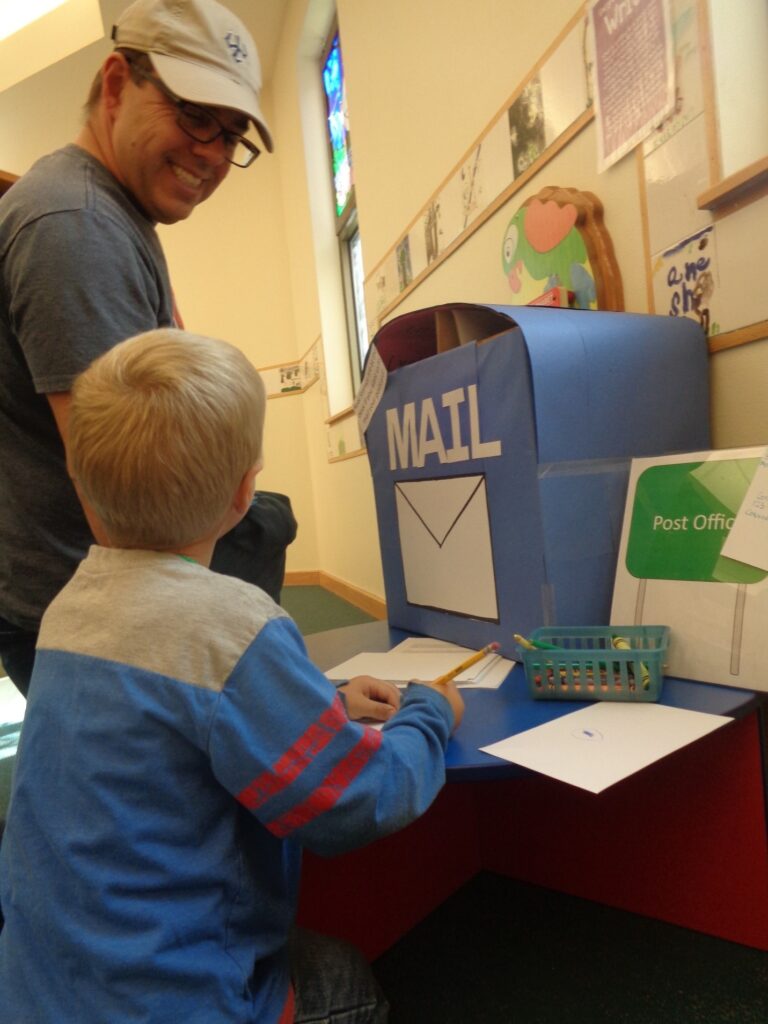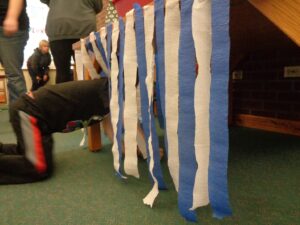In October, the Montrose Regional Library hosted an early literacy event titled Tape Town. Customers were invited to bring their toy cars and visit the children’s room where a volunteer and I had laid down roads of masking tape all over the room.
While the tape was by far the most daunting task, I’d like to talk more about the rest of the program. Tape Town was designed to allow caregivers space to practice early literacy with their child and simulate real-world environments where caregivers often go with their children; the grocery store, bank, post office, community garden, and car wash. The core of this event, though, was play.
My goal was to transform our children’s room into an interactive playscape for kiddos with different stations replicating real-world experiences.

The first stop was at the children’s reference desk DMV where I explained to caregivers what was going on in the room and created a driver’s license for each kiddo with their photo on it. The kiddos got to write their name and their age on their driver’s license then rent a car to drive around the room if they did not bring their own.
Next stop, the community garden. I had a simple garden craft where kiddos were encouraged to plant rows of seeds (scraps of paper) onto their garden plot. I had a handout at the station explaining the importance of fine motor movement in relation to early literacy and encouraged the parents to talk to their children about what kind of plants each color of paper would grow into. Perhaps the blue paper is blueberries or columbine flowers. Red may be radishes or apples.
At the bank station, kiddos created their own piggy banks to take home. I had collected coffee cans (I’m a librarian, I drink a lot of coffee) and cut construction paper for the kiddos to decorate. My handout included tips on dramatic play using real money.
The next stop was the post office. We fashioned a cardboard box to look like a mailbox and cut cardstock to postcard size. Kiddos got to decorate their own postcards and learn how to address mail. We also provided real postcard stamps at the desk if the kiddos wanted us to mail out their postcard.

The car wash was a fun sensory experience. I taped streamers to the bottom of a table for kiddos to drive their cars through and provided bins of pompom “soap” so they could wash their cars.


Finally, our kitchen playspace was turned into a grocery store where each kiddo got shopping lists with real images and names of food for the kiddos to fill a basket with our play food.
At each station, I included tip cards that talked about the five ECRR skills and how we can develop these skills in day to day experiences. Some of these tips included:
Sing!
Have you heard “Car Wash” by Rose Royce? What a fun song to sing to your child! The songs you sing with your child don’t have to be only “kids” songs, they can be songs that you enjoy too! When you are with your child, go ahead and belt your favorite tunes, you don’t have to be on key for your child to get benefit from singing. Songs help your child develop many important skills such as rhythm, phonemic awareness, and it’s just plain fun. Want to make this experience even more valuable for your child? Hold them and dance along as you sing!
Talk!
Our post office is really echo-y. Although I wouldn’t recommend going to the post office to play with your child’s echo (which may be super fun but might upset some of the employees), providing your child opportunities to play with their echo will help them with their phonological awareness! Using PVC pipe, you can create a simple whisper phone for your child to emulate their voice into, practice loud and soft, and practice different sounds. No PVC pipe? Anything hollow will do. Try talking into the underside of a toy drum or a steel mixing bowl.
Read!
The grocery store is full of signs! As you are shopping for produce, ask your child how many “A’s” you can find. Apple, Asparagus, Arugula. Letter knowledge is one of the primary skills necessary for your child as they are learning how to read!
Write!
As your child is planting their “seeds” they are building important fine motor skills. These fine motor skills will later help them when they are learning how to write! For even more fine motor skill fun, create a mud squish bag for your kids. Fill a small ziplock bag with mud and have your child practice writing letters or their name. Even just squishing the mud in the bag will help with essential fine motor skills.
Play!
Your child may be used to washing their body, but are they used to washing other things? Messy play is so fun and a great sensory experience for your child! Have your child dirty some toys such as plastic animals in the mud (or for an edible experience, pudding) and have your child wash them off with water.
The program was a great success! The kiddos had a blast and the caregivers left with some new tips to provide literacy-rich experiences in their daily routine.
